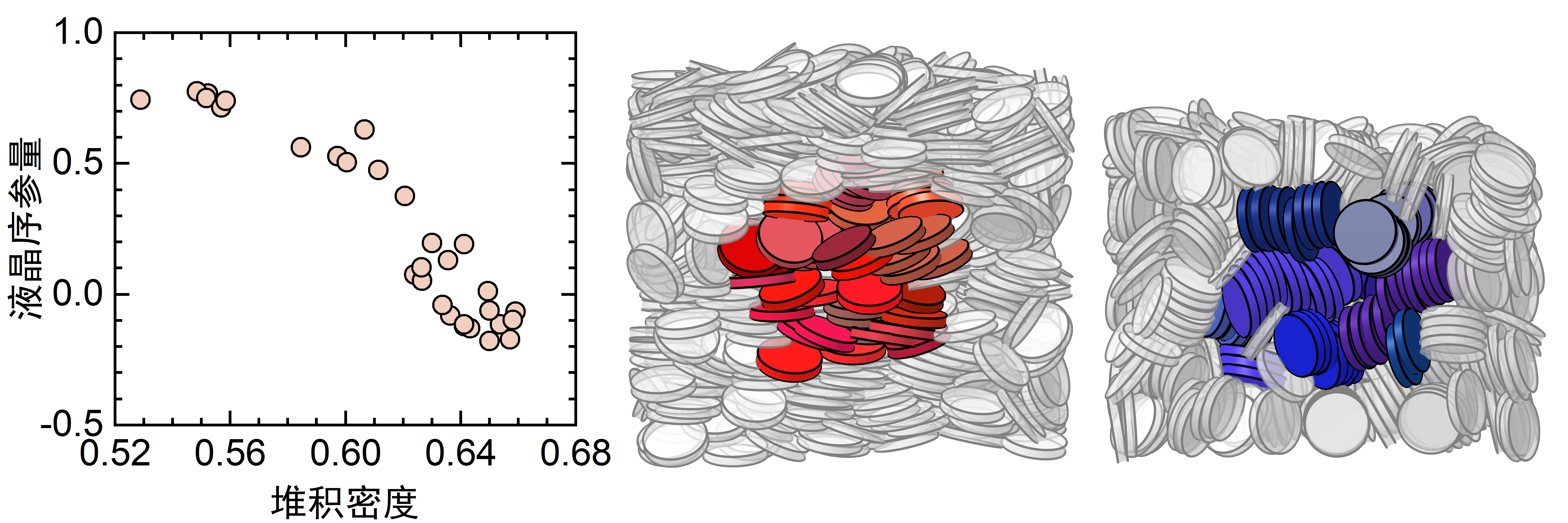# Hot Search #
Xia Chengjie, a researcher from the School of Physics and Electronic Sciences of ECNU, along with Hu Bingwen’s team of Shanghai Key Laboratory of Magnetic Resonance, have made a new discovery about the anomalous structural ordering transition in the stacking of disk-like particles. By using magnetic-resonance imaging techniques, the results from their research findings reveal the essential differences and profound connections between the macroscopic disk-like particle systems and the microscopic disk-like liquid crystal molecular systems.
The stacking of disk-like particles is a universal problem in many scientific and industrial fields, such as disk-like liquid crystal molecules, clay particles, graphite layers in batteries, and even some industrial raw materials or flat gravel debris. Thus, it is valuable to understand and control the stacking structure of these systems, which are crucial for comprehending and manipulating their macroscopic mechanical and transport properties.
For particle systems in thermal equilibrium, there are relatively mature theoretical models for analyzing the statistical regularities of their stacking structures, while for more common macroscopic particle systems in non-thermal equilibrium, the basic geometric features of their packing structures are not yet known. For example, how coins are arranged after being thrown randomly into a piggy bank still remains a mystery to researchers in the field.
The applications of magnetic-resonance imaging and image processing techniques allow researchers to reconstruct the stacking structures of coin-shaped disk-like particles. For example, they found that the macroscopic orientation order of the disks has decreased as the stacking system became denser (Figure 1). If there appears to be more order among the structure of the particles, then the closer they can be arranged. In this explanation, the anomalous phenomenon is opposite to the phase transition observed in rod-like or disk-like hard particles in thermal equilibrium, making it challenging to understand through classical Onsager’s theory of entropy-driven phase transitions.

The order parameter of the liquid crystals of disk-like particles decreases with the increasing packing density. In sparse packing, the particles are scattered and the overall orientation is along the vertical direction; in dense packing, the particles stack together and the overall orientation becomes disordered.
Through more in-depth structural analyses and the construction of statistical mechanical models, researchers believe that the packing structures of disk-like particles were initially formed at a small scale, and that these stacking structures mutually “block” each other. Due to this process, it is creating a blocked state that cannot further relax into a more ordered structure, which in turn reduces the orientation order of the system at a larger scale.
This structural transition mechanism also reflects the profound connection between the particle stacking systems and the glassy systems. Research on typical non-thermal equilibrium systems can also help understand the complex metastable phenomena of disk-like microparticle systems in non-thermal equilibrium states, establishing a more universal statistical mechanical model.
In recent years, the research team has continuously explored the application of magnetic resonance imaging in particle physics and soft matter physics. This process has achieved a series of innovative results, which have caused new findings from the latest field research. For instance, some representative achievements include the cubic symmetry phase transition of cylindrical particle stacking (Soft Matter,18, 726 (2023)) and the properties of the blocked states of hydrogel soft particles (Soft Matter,17, 2963 (2021)).
Those recent studies have fully leveraged the advanced magnetic-resonance imaging technology to successfully reconstruct the stacking structure of disk-like particles, which was previously a challenging idea. In the future, the research team will continue to explore new modes of interdisciplinary research between magnetic-resonance imaging and soft condensed matter physics.


Research published in Physical Review Letters and featured on the APS Physics webpage
Relevant research was published in Physical Review Letters on September 1st under the title of “Structural Transformation between a Nematic Loose Packing and a Randomly Stacked Close Packing of Granular Disks”, selected as “Editor’s Suggestion”, and featured in a Focus article on the homepage of the American Physical Society’s Physics website (https://physics.aps.org/articles/v16/150). The first author of the paper is Ding Yunhao, a master’s student of ECNU (who is currently studying abroad in the UK). The research involved the participation of Prof. Hu Bingwen and Prof. Li Jianqi. Moreover, this research has been supported by the National Science Fund for Distinguished Young Scholars and other programs.
Paper’s Link: https://journals.aps.org/prl/abstract/10.1103/PhysRevLett.131.098202


















